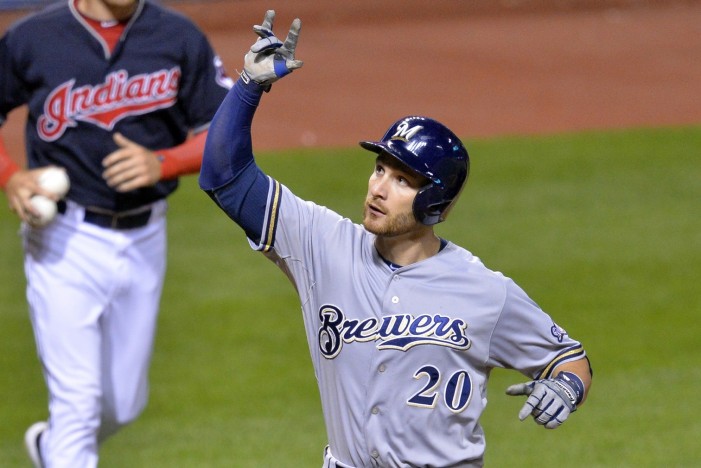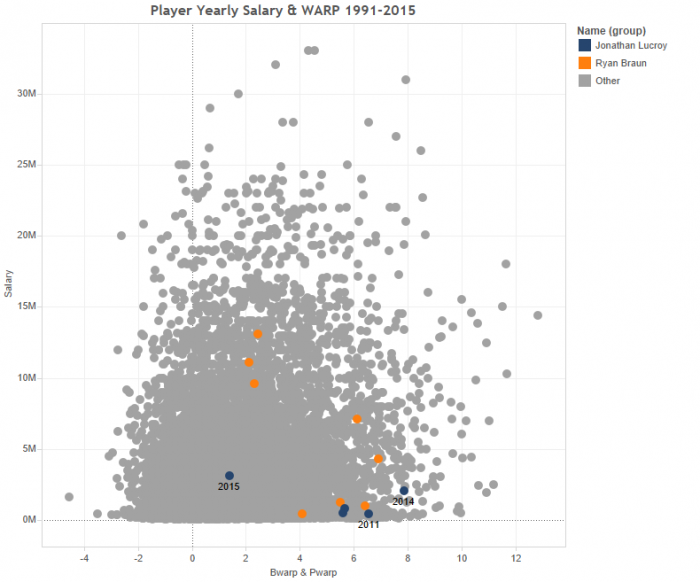The Brewers are in a predictable course of action. They’re rebuilding. Since July, the Brewers have traded Carlos Gomez, Mike Fiers, Francisco Rodriguez, Adam Lind, Jason Rogers, Aramis Ramirez, Jonathan Broxton, Gerardo Parra and, most recently, Khris Davis.
In essence, the Brewers are trading anyone who will garner them young and controllable assets, mainly in the form of prospects. In the Khris Davis move, the Brewers acquired young catcher Jacob Nottingham and right-handed pitcher Bubba Derby. This spurred a narrative that the acquisition of Nottingham meant Jonathan Lucroy is guaranteed to be traded. The narrative is false, as Lucroy was likely going to be traded even without Nottingham. But his acquisition is important for the Brewers in that they potentially have acquired their catcher of the future, the one who will eventually replace Lucroy. The trade also means that the next big chip to fall should be Lucroy.
The Brewers’ backstop struggled last year, more than any other season in his past, which will make him a little more difficult and complicated to trade. With that being said, even though Lucroy struggled and has some very concerning performance trends, he still has one of the team-friendliest contracts in baseball, which will increase his value on the trade market.
Now, Lucroy’s contract is team-friendly because he, comparatively, isn’t making a lot of money. In the 2011/2012 offseason, Lucroy signed a five-year contract worth $11 million with a club option for 2017. That’s ridiculously low for any non-league-minimum player, and those numbers don’t even consider Lucroy’s production.
Therefore, these on-the-field numbers don’t tell the full story. They don’t describe just how team-friendly Lucroy’s contract is or in which year the Brewers experienced the biggest bargain for their buck. For example, if he performs at a below-replacement-level rate, then the contract isn’t all that team-friendly. Instead, Lucroy would just be another body on the bench. But, if he performs well, then the contract becomes very beneficial to the team, which is what has happened throughout his tenure in Milwaukee.
In order to find out, how team-friendly Lucroy’s contract was and which years the Brewers benefitted most from it, I looked at the relationship between his yearly salary with his BWARP. I then did the same thing for every player from now until 1991. The reason is that I got the players salary from USA Today’s salary database. Keep in mind that these salaries are only for opening day players. That’s why, for example, you won’t see Lucroy’s 2010 season in the following graphic. That season Lucroy joined the team in midstream. I also included pitchers PWARP so that I could compare Lucroy to the pitchers as well.
(Please see the interactive version of the workbook here: https://public.tableau.com/profile/julien1554#!/vizhome/PlayerYearlySalaryWARP1991-2015/Sheet1)
The biggest and most obvious observation to be made is that in 2015 Lucroy wasn’t as big of a bargain as he has been in years past. This is not to suggest that Lucroy’s contract became an albatross in 2015, but rather that he wasn’t ridiculously valuable to the same degree as he was from 2011-2014. The 2014 campaign was when the Brewers were able to mostly benefit from the player’s team-friendly contract. Not only was Lucroy cheap, but he was one of the most valuable players in the game. In fact, the only three players in Major League Baseball to have a better BWARP than Lucroy in 2014 were Mike Trout, Giancarlo Stanton, and Buster Posey. Good company.
Now, looking at the information from 1991-2015 can be misleading, mainly because contracts have increased dramatically over that time frame. Therefore, to give one a better look at how valuable Lucroy truly was, it’s best to look at the data from 2011-2015.
This makes Lucroy’s contract look even better. In 2014, Lucroy produced 7.85 BWARP, while only making a little more than $2 million. During that time frame (2011-2015), players have produced more BWARP & PWARP while making less than Lucroy only three times. Two of those seasons were by Mike Trout and one by Buster Posey. Plus, by shifting the data from 1991-2015 to 2011-2015, the shape of the image changes (as can be seen in the interactive version of the workbook). It’s obviously a lot thinner on the sides and at the lower portion of the graph. Meaning that as the years have progressed, players have been making more and more money annually. (This can be seen in an even clearer way by reducing the years in the opposite direction, going from 2015 to 1991, and you can see that the data has completely changed. In fact, in 1991, not a single player made more than $5 million annually.) Making Lucroy’s current contract plus production look like even more of an outlier, especially his 2014 season, which can only be described as one of the biggest bargains in modern times.
That being said, Lucroy’s 2014 season might be the biggest bargain in Brewers history. If one goes to the team section and types in “MIL” there will be a number of values that pop up. For simplicity’s sake, simply select the “MIL” tab. The others would include players that played on multiple teams that same season. If you wish to include all the players that played for Milwaukee during those years, then select all the tabs. In any case, with the years still at 2011-2015, one can clearly see that Lucroy is in a league of his own. The only player that even approaches him is Jean Segura’s 2013 season, where Segura made just under $500k and produced 5.5 BWARP. Even by including every season, for the Brewers, Lucroy’s 2014 season is still the biggest outlier, when considering the production with his salary.
There’s still a lot to unpack from this visual and the information within it. For example, one can look at Kyle Lohse and Matt Garza to see how bad those contracts were for the Brewers. Or, perhaps, looking at Ryan Howard who can be found at the top left of the graph.
This information also does not give one a perfect ranking of Lucroy’s team-friendly contract. It rather shows the relationship between the salary and WARP. But, it does give one a sense of the situation. The lower down and to the right-hand side of the graph the player is, the more team-friendly the deal. The more the player is on the top left-hand side of the graph, the worse the contract.
In practically every year Lucroy is in the lower right-hand side of the graph. And, for the Brewers side, it would be difficult to argue that it’s not the friendliest contract since 1991. There’s a very good chance this will be Lucroy’s last season in a Brewers uniform, and he’ll definitely be remembered for a number of things. But, one that should not be forgotten is his level of production while playing under a contract that vastly undervalued him.

